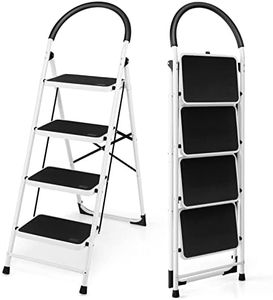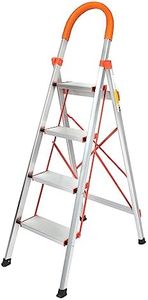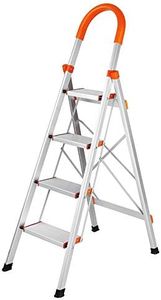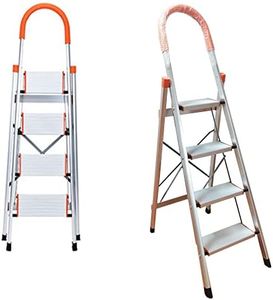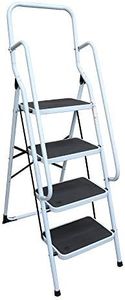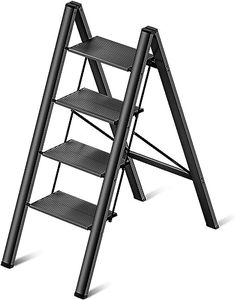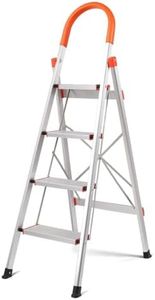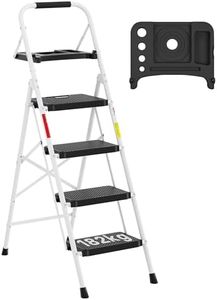We Use CookiesWe use cookies to enhance the security, performance,
functionality and for analytical and promotional activities. By continuing to browse this site you
are agreeing to our privacy policy
10 Best 4 Step Ladder
From leading brands and best sellers available on the web.By clicking on a link to a third party's website, log data is shared with that third party.
Buying Guide for the Best 4 Step Ladder
Choosing the best 4-step ladder may seem straightforward, but taking the time to match the ladder’s features to your needs will make your tasks safer and easier. Consider where and how you’ll use the ladder: indoors or outdoors, for jobs like painting, repairs, or reaching storage. Focus on stability, comfort, and durability, as well as portability if you need to move it often. Understanding the main specifications will help you select a ladder that fits your tasks safely and comfortably.MaterialThe material of a ladder affects its strength, weight, and resistance to corrosion. Ladders are commonly made from aluminum, steel, fiberglass, or plastic. Aluminum is lightweight and rust-resistant, suitable for most indoor tasks and easy to carry, but may conduct electricity, so it's not ideal for electrical work. Steel ladders are sturdy but heavier, and can rust if used outdoors without proper coatings. Fiberglass ladders are durable and don't conduct electricity, making them a top choice for working near power sources, though they are often heavier and more expensive. Plastic ladders are light and don’t rust but are usually only strong enough for light tasks. Before choosing, think about whether weight, safety near electricity, or weather resistance matters most for your typical uses.
Load CapacityLoad capacity indicates the maximum weight the ladder can safely hold, including your body weight and any tools or materials you’ll carry. Common types are: Type III (up to 200 lbs, for light household use), Type II (up to 225 lbs, suitable for medium-duty chores), Type I (up to 250 lbs, for heavier DIY and professional use), Type IA (up to 300 lbs, heavy-duty for professionals), and Type IAA (up to 375 lbs, extra heavy-duty). To choose the right load capacity, add up your weight and the heaviest tools or materials you might bring up the ladder, then select a ladder that can safely support that total.
Step Size and TreadStep size and tread refer to the width, depth, and surface texture of each step. Wider and deeper steps provide more comfortable and stable standing space, reducing foot fatigue during longer tasks. Tread or anti-slip surfaces prevent slipping, especially if you're climbing with wet or dirty shoes. Ladders with larger, textured steps are better for long periods of standing or frequent up-and-down movement, while smaller steps may be okay for short, simple reach jobs. Think about comfort and safety: choose a ladder with wider, anti-slip steps if you plan to stand for a while or if safety is a big concern.
Height and ReachA 4-step ladder’s standing height and reach indicate how high you can safely work. The standing height is typically the topmost step you can stand on, while reach height is where your hands can comfortably reach when you stand on that step. Knowing your ceiling or task height is key: a 4-step ladder usually helps you safely reach heights between 8 to 10 feet. Pick a ladder where you can complete your tasks without standing on the very top, as this is unsafe. Estimate the height you often need, then check if a 4-step ladder gives you a safe, comfortable reach.
Weight and PortabilityThe weight of the ladder affects how easy it is to move, carry, and store. Lighter ladders made from aluminum or plastic are simpler to transport, ideal if you’ll take your ladder from room to room or even outside. Heavier ladders may be more stable but could be tiring to move or store in tight spots. Consider where you’ll use the ladder: if you plan to maneuver it often, choose a lighter option; if it will mostly stay in one place, weight may not be as important.
Stability and Safety FeaturesStability and safety features include wide bases, non-slip feet, locking mechanisms, and handrails. These make the ladder steady and reduce the risk of sliding or wobbling when you climb. Non-slip feet help on smooth or uneven surfaces, while a strong locking system prevents sudden folding. Some ladders have handrails or project trays for added support. If you want extra reassurance, look for stability features, especially if you’ll use the ladder in areas with hard floors or outdoors.
